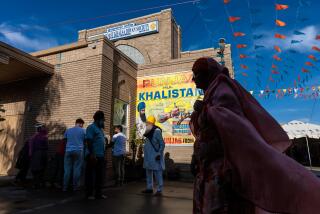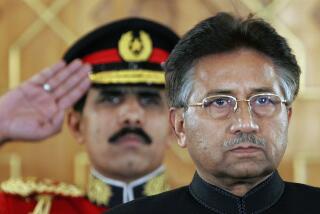Militants’ rise in Pakistan points to opportunity missed
- Share via
WASHINGTON — The U.S. and its allies squandered an opportunity to cement alliances with tribal elders they regard as key to driving Islamic extremists out of havens along the Pakistan-Afghanistan border, and now face a long and costly effort to regain influence there, counter-terrorism officials and diplomats say.
The Pashtun maliks, or elders, wield enormous political and social power, especially in Pakistan’s largely ungoverned tribal areas bordering Afghanistan. But Washington and its allies in Islamabad and Kabul have not made it a priority to forge alliances with them, despite evidence that Al Qaeda and the Taliban are growing stronger in their territories, these officials say.
Once established, the militants have slain or threatened hundreds of these tribal leaders in a campaign that U.S. officials say has seriously undermined counter-terrorism efforts.
That missed opportunity underscores a fundamental U.S. policy failure: Of the billions of dollars spent, little has gone toward counter-insurgency efforts such as working with tribal leaders to determine how to help their constituents, according to U.S., Pakistani and Afghan officials.
As a result, they say, Al Qaeda and the Taliban are doing a far better job of expanding their insurgency than the United States and its allies are of trying to stop it.
Reversing the damage will require many years of aggressive counter-insurgency efforts, said one senior State Department official involved in South Asia issues.
“It’s hard, and an incredible contribution of resources, and you have to do it village by village,” said the official, who spoke on condition of anonymity, citing international sensitivities. “But you have to start somewhere.”
Pashtun tribes have ruled large parts of Pakistan and Afghanistan for centuries, largely outside government control. Generally they are not militant Islamists, but under their tribal code they are obliged to provide sanctuary to anyone who requests it, including extremists.
After the U.S.-led forces routed the Taliban in 2001, most surviving militants slipped across the border into Pakistan. U.S. officials pressed Pakistani President Pervez Musharraf to forge alliances with tribal leaders, especially when it became apparent that Al Qaeda and the Taliban were gaining strength, said Henry A. Crumpton, who was the State Department’s ambassador at-large for counter-terrorism from 2005 to ‘07, and before that a senior counter-terrorism official with the CIA.
But the U.S. strategy, sharply criticized by a recent U.S. Government Accountability Office audit, did not require Musharraf to build ties with tribal leaders, according to Crumpton and other current and former U.S. officials and experts. Washington also provided more than $10 billion in aid, mostly military, which the GAO report says was not adequately monitored.
Musharraf used most of the aid for hardware best suited to battling India, Pakistan’s neighbor and rival.
Pakistan’s infrequent military incursions into the tribal areas usually were followed by a quick withdrawal, angering the tribes and leaving potential allies vulnerable to accusations of spying for the government, according to U.S. and Afghan officials and members of the newly elected Pakistani government.
As Al Qaeda and the Taliban grew stronger, they turned on their hosts, killing tribal leaders who opposed extremist pressure to close down girls schools, barbershops, stores selling videos and other items perceived as trappings of Western culture.
The State Department official estimated that 120 to 140 senior tribal leaders were killed in Pakistan, many in the last 18 months. Militants often leave warning notes pinned to bodies.
“Any tribal leader who has committed to the government is seen as a threat to the Taliban and Al Qaeda, as betrayers of Islam,” said M. Ashraf Haidari, Afghanistan’s counselor for Political, Security and Development Affairs in Washington. “They can be targeted and some have been killed.”
Many tribal leaders have become more supportive of the Taliban and Al Qaeda, or are reluctant to take action against them, the U.S. officials and experts said. And development and outreach efforts in both countries, particularly U.S.-sponsored projects, have foundered.
“It’s like an old-fashioned gang war. And at the end of the day, Al Qaeda had the money and the guns and they won the gang war,” said Rep. Adam Smith (D-Wash.), who led a fact-finding delegation to the region last month as chairman of the House Terrorism and Unconventional Threats and Capabilities Subcommittee.
“It will be very hard for us to find people to work with,” Smith said. “Al Qaeda has successfully killed off people who might have opposed them.”
Militant leader Baitullah Mahsud rose to power after his followers killed several prominent leaders of his own tribe in South Waziristan.
He then helped create a coalition of tribal-based militants known as Tehrik-e-Taliban that U.S. and Pakistani authorities say is responsible for a wave of attacks on troops, civilians and officials in both countries, including the assassination of former Pakistani Prime Minister Benazir Bhutto last year.
U.S. officials are now concerned that the peace accords the new Pakistan government is trying to negotiate with Mahsud and pro-militant tribal leaders will allow Al Qaeda and the Taliban to solidify their base in the area. And some U.S. lawmakers oppose continued funding for Islamabad, including money earmarked for tribal security forces that they fear have been compromised by the Taliban and Al Qaeda.
“We don’t want to strengthen the Pakistani tribes if they’re going to misuse the additional military support,” Sen. Carl Levin (D-Mich.), chairman of the Armed Services Committee, said last month after visiting Pakistan and Afghanistan.
At the same time, at Washington’s urging, Pakistan and Afghanistan are making efforts to cultivate influential tribal leaders and encourage them to expel foreign Al Qaeda fighters and the local pro-Taliban militants who support and protect them, said Smith and current and former officials of the three countries.
Husain Haqqani, Pakistan’s new ambassador to Washington, said the government is reaching out to those it believes are still open to expelling Al Qaeda and Taliban fighters. He said continued U.S. aid is crucial to the new government’s plans to offer incentives such as new schools and roads.
But many fear that such efforts may be too little too late. Members of Al Qaeda and the Taliban have become well- entrenched, often marrying into local populations.
Crumpton, the former counter-terrorism official, said the three nations need to move much more aggressively because tribal leaders could form the backbone of a counter-insurgency effort.
He cited the example of Afghanistan, where the CIA, with help from a few hundred U.S. special forces soldiers, managed to topple the Taliban in 2001 by forging alliances with influential tribesmen. Crumpton oversaw that effort.
“It will be harder now,” he said. “We had such a huge window of opportunity from 2002 to 2004,” before Al Qaeda and the Taliban regrouped. “It has not closed, but it is smaller.”
One State Department official familiar with South Asian issues said Al Qaeda and the Taliban are in effect daring the U.S. to try. They are spreading word that the U.S. will abandon Pashtun tribesmen in both countries, just as it did in 1989 after they worked closely with the CIA and U.S. military to expel Soviet forces from Afghanistan, the official said.
“They are saying that the United States does not have the stamina or will to stay in South Asia indefinitely,” the official said. “And that when they are gone, we will still be here and you will have to live with us, and we are keeping lists and keeping track of names.”
--
More to Read
Sign up for Essential California
The most important California stories and recommendations in your inbox every morning.
You may occasionally receive promotional content from the Los Angeles Times.










